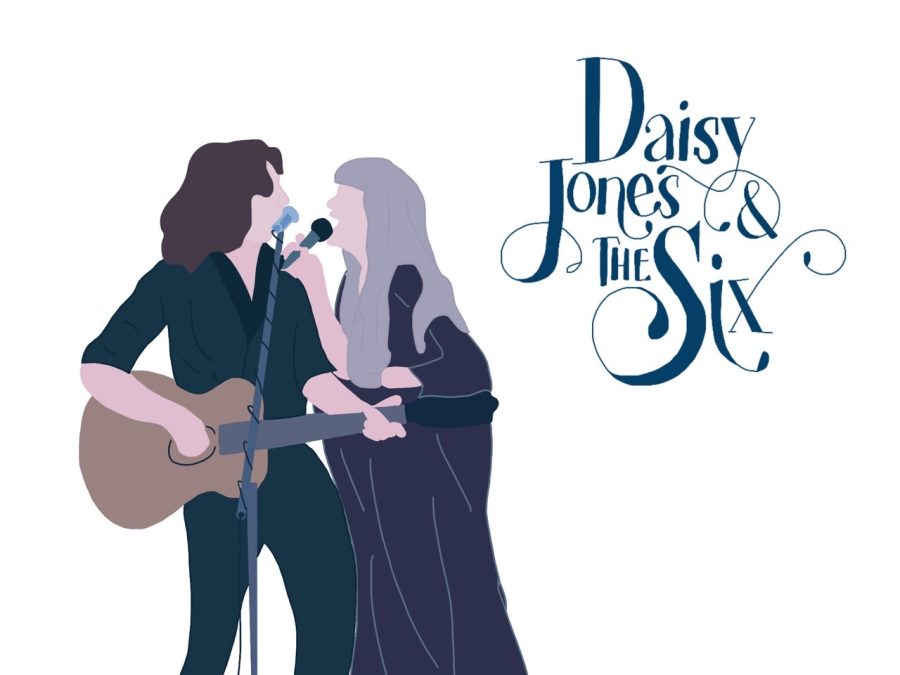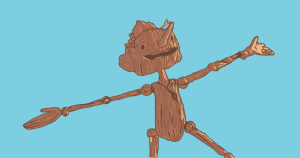Drama series ‘Daisy Jones & the Six’ sparks a fire that burns twice as bright but ultimately only half as long
Musical adaptation attempts to shade in its ensemble and period settings with nuance, but is ultimately paper-thin
Lead singers Daisy Jones (Riley Keough) and Billy Dunne (Sam Claflin) of Daisy Jones and the Six perform a song from their album “Aurora.” The show tracks the development of the complex dynamic between Billy and Daisy as the band rose to the top of the music world in the 1970s before its members went their separate ways.
April 22, 2023
An adaptation of Taylor Jenkins Reid’s 2019 bestselling novel, Daisy Jones & the Six is structured as an oral history of a band, with the complicated dynamic between the two lead musicians at its center meant to evoke the real-life relationship between Stevie Nicks and Lindsey Buckingham of Fleetwood Mac. Beyond this clear connection though, the titular band deviates from the trajectory of its inspiration significantly. After ascending to the top of the music world in the 1970s, the band suddenly stopped making music and went their separate ways after one album and one sold-out show at Soldier Field in Chicago. In the 1990s, the members have agreed to be interviewed for the first time for a documentary about what led to the abrupt dissolution of the band. There’s lead singers and songwriters Daisy Jones (Riley Keough) and Billy Dunne (Sam Claflin), lead guitarist Graham Dunne (Will Harrison), bassist Eddie Roundtree (Josh Whitehouse), drummer Warren Rojas (Sebastian Chacon), and keyboardist Karen Sirko (Suki Waterhouse). The bulk of the story is presented in flashback, providing context for the bitterness and contempt that colors Daisy and Billy’s current day relationship.
The first few episodes show the parallel stories of Billy and Daisy on a collision course, with their creative geniuses destined to collide. Under the influence of a cold and dismissive mother, Daisy grows up with a constant need to prove her own self-worth, determined to be defined as more than a man’s muse but finding opposition at every turn. After getting her song stolen by one guy and having her talents belittled by another, she proclaims “I’m not the muse, OK? I’m the somebody.” It’s Billy’s recognition of this fact that, in the show’s best moments, makes their relationship such a joy to behold.
Billy, on the other hand, is the lead singer of a popular but uninspired cover band in Pittsburgh that consists of Graham, Eddie and Warren. It’s the introduction of Camila (Camila Morrone) that gives Billy and the band the creative spark needed to bring in keyboardist Karen Sirko (Suki Waterhouse) and refashion themselves as The Six.
If anything, having record producer Teddy Price (Tom Wright) introduce Daisy to The Six so soon after the Six is formed is to the show’s detriment, as there isn’t enough time to flesh out the other band members before the show becomes the “Billy and Daisy Show.” Their dynamic, however, evolving from one of outright contempt to grudging respect and finally to romance, does make for compelling television. It’s one characterized by constant tumult, ebb and flow, push and pull, with Riley Keough and Sam Claflin’s magnetic performances selling it perfectly.
As Daisy, Riley Keough is a livewire, bristling with humanity, energy, contempt, and overflowing intensity. She embraces the show’s constantly shifting narrative rhythm and madness whenever it needs her to with equal measure, and she is absolutely fearless as a result. Claflin is at his best when he’s struggling with his growing attraction to Daisy and the familiar, if not passionate, love he has for the wife who stayed by his side even as he descended into drugs and addiction. It’s an internal conflict that’s afforded a sincere amount of depth, sustaining interest even after Billy, Daisy, and Camila find themselves engaging in a frustrating love triangle midway through the series.
It’s at this point that the show’s narrative momentum starts to dwindle. There’s a scene where Rod Reyes (Timothy Olyphant), the band’s tour manager, suggests adding some pyrotechnics to their performances. Daisy, in response, says “I’m the fire.” By that point, however, the show had so struggled to maintain the burning intensity of those early episodes that no one is convinced.
Further stifling narrative heft is the show’s missed opportunity with its period setting. In the 1970s, a decade rife with paranoia and fascination due to events such as the Vietnam War and Watergate, the show’s setting should be expansive; instead, it feels strangely claustrophobic, primarily being confined to the recording studio and Billy’s house for episodes at a time. The show does make admirable attempts to dip into more controversial 1970s waters in the form of Daisy’s best friend Simone, a successful singer whose girlfriend must be hidden from the public. In the end, however, this promising character is pushed aside in favor of the long triangle angle, at the cost of the thought-provoking themes of fame and women’s role in the music industry that Simone’s storyline had the potential to explore.
If all the other characters are merely reduced to background players in favor of the series shining its narrative spotlight on its two leads, then Camila is the only other character that’s afforded actual shading and texture, thanks to Camila Morrone’s excellent performance. She imbues her character with such a warmth, vulnerability and verve not often owed to the long-suffering wife character trope. She elevates the otherwise dull love triangle storyline by refusing to treat Daisy as the “other woman” in her relationship; instead, Camila directs her anger towards Billy, getting to make the choice to leave her relationship when she reaches her breaking point and realizes that she can’t make Billy happy anymore. The end result is a character with her own agency, desires and self-respect, and the one who arguably forms the show’s backbone.
Ultimately, the series does succeed in giving an illusion of depth amidst the heady thrill of watching the band get together to make music history. By the end of its too-long run though, the glossy veneer has worn off. After feinting one too many times when it should be digging deeper, Daisy Jones & the Six reveals itself to be what we as viewers knew it was all along: disappointingly hollow.







